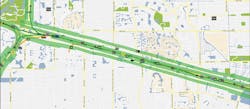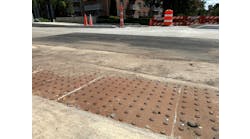The Florida Department of Transportation (FDOT) signed a public-private partnership (P3) agreement with I 595 Express LLC to serve as the concessionaire to design, build, finance, operate and maintain the roadway infrastructure, including reversible lanes, along the I-595 corridor for a long-term commitment of 35 years.
Part of this concession agreement includes the design, installation, maintenance and operation of a very complex intelligent transportation system (ITS) for I-595. This includes the design, installation and operation of an interim traffic-management system (ITMS) to be utilized during the five-year construction period, a reversible express lanes access control system (ECS) and the permanent traffic management system, altogether referred to as the ITS.
The I-595 project will consist of the addition of three tolled express lanes along the median of the highway and the reconstruction and expansion of most of the interchanges, entrances and exit ramps. During the five-year construction, the existing ITS originally installed in the highway has to be removed and replaced with an ITMS utilizing self-contained trailers with ITS equipment. The ITMS trailers are connected to the traffic-management center (TMC) via wireless and fiber-point connections. I 595 Express LLC is responsible not only for the deployment and maintenance of the ITMS system but also for its operation from the shared FDOT District 4 TMC facility.
As part of the construction work, a new, permanent ITS will be installed to not only monitor and control the traffic flow on the general-purpose lanes of I-595 but also to control and monitor the traffic on the express lanes; most importantly, it will provide access control to the traffic utilizing the express lanes. A separate component of the ITS system is the emergency access gates system to allow emergency vehicles to enter or exit safely from the express lanes during emergencies.
Animated trailers
Rapid deployment, reliability of the equipment and the ability to reposition trailers at short notice were some of the most important requirements of the ITMS system. A total of 26 self-contained trailers with five wireless repeater stations installed on concrete poles compose the ITMS. The trailers contain a combination of CCTV cameras, microwave detection devices and dynamic message signs (DMS)powered by solar power and
portable generators.
Daily challenges are posed to the installation and operation of the ITMS system, of which the most significant one is the active construction on the road. Selection of each one of the trailer sites was coordinated with each one of the construction phases not only to place the ITMS trailers in areas where construction activities will not be disrupted, but also to ensure that the trailers can accomplish their functionalities of traffic monitoring and control.
A wireless communication system was chosen as the best way to interconnect the ITMS trailers and at the same time have the flexibility to relocate them along the road and maintain the communication connectivity.
Full-grown ITS
There are two major components to the permanent ITS to be installed on I-595: the “standard” ITS and the ECS. The “standard” ITS deployment consists of CCTV cameras, vehicle-detection devices, highway advisory radio, dynamic message signs and the communication system. The purpose of this system is to monitor and control the traffic along the entire I-595 corridor including the express lanes.
The second system, the ECS, is required to control the entrance and exit points to the reversible express lanes and includes a mechanized and automated emergency-access gate (EAG) system. The express lanes will function as a reversible system, where during certain hours of the day, the lanes will carry traffic in one direction only and then reverse and carry traffic in the opposite direction. The main purpose of the express lanes is to augment the capacity of the road to carry traffic during peak hours.
Safety is the premise of the operation of the express lanes; consequently, the ECS will be designed, installed and operated on that founding principle. The system designer’s focus is to ensure that it will not only be safe but also reliable and easy to maintain.
Five entrances—two for eastbound traffic and three for westbound traffic—will be the access locations to the facility. Each one of these entrances will be controlled via an access control unit (ACU).
Real-time decisioning
The purpose of the I-595 ITS system and its components is to collect and transmit to the TMC real-time data and live video from field devices located along the corridor, enabling the TMC operators to make traffic-management decisions and allowing communication via the DMSs to the road users. Information transmitted between the field devices and the TMC also will be used to operate the reversible express lanes and deploy emergency and motorist-assistance services. The ITS system also will have a high level of automation, analyzing real-time traffic data, used to (a) provide travel-time information to road users and (b) manage general-purpose and express-lane traffic and toll rates. Third-party entities such as emergency responders also will have access to video from the corridor to enable monitoring and emergency planning.
The following are the elements related to the safe operation of the reversible lanes (express lanes) following a safe management access approach.
Changeable message signs (CMS) and lane-control signals (LCS)
A series of CMSs and LCSs will be installed at every entry point to the express lanes. The purpose of the CMSs and LCSs is to provide the motorist with a visual indication of whether the express lanes are open or closed from the direction of travel. The system is placed in advance of the express-lane access points and is the first indication of the status of the express lanes. It will be supported by the express-lane barrier system, which will provide a physical control point to the express lanes.
Warning and barrier gates
Each one of the entrances will consist of a series of warning gates (breakable) that provide a physical and visual deterrent to prevent motorists from entering the system in a closed state. One barrier gate per entrance will provide a nonintrusive barrier that will prevent any vehicle from entering the system in a closed state. The entry barrier system is operated in sequence with the CMS and LCS as described below.
EAGs
The EAG system is a unique element to the I-595 project in support of the safe operation of the road. The purpose of the EAGs is to provide access for authorized emergency vehicles to the express lanes. They are located along I-595 at points designed to be as close as possible to existing on-ramps to minimize emergency-response times.
The EAGs are supported by a shoulder barrier protection system to provide safer entry into the express lanes. This is achieved by protecting the shoulder at the EAG entry point through the opening of a lightweight barrier system in advance of the EAG opening, thereby warning the motorists of merging vehicles. Another component of the EAG system is the flashing beacons that are activated when the EAG is opening to alert drivers of the operation of the gates.
To control congestion
The express lanes ECS control sequence consists of automated, programmed logical instructions initiated through human actions on the SunGuide system (FDOT’s traffic-management system) and purposeful human checks and triggers occurring in a designed sequence. The ECS module designed to function on the SunGuide platform will be operated from the TMC. The I-595 express-lane control module will consist of an express-lane status display unit, which provides a graphical representation of the express-lane entry and exit point components and all the EAG components on combined screens. Operation of the ECS system is through a point-and-click interface with information input screens that require keystroke input.
The express lanes will provide a reliable travel option eastbound in the morning and westbound in the afternoon. Motorists will have to pay a toll (using all-electronic open-road tolling) for their use. The toll charge is variable and will be a mechanism used to manage congestion. The express lanes will be used in the direction of peak traffic flow and will add to the total highway capacity. As the express lanes are seen foremost as a traffic management tool, the intent is to set the toll rates so that there is general optimization of traffic along the I-595 corridor. This means that the toll rates can be varied to attract traffic to the express lanes to alleviate congestion in the general-purpose lanes.
A pricing-system software module that includes multiple algorithms that can be used to calculate the toll rate amount is being developed for the I-595 express lanes. Different algorithms on the pricing-system software will allow the department to select the best way to calculate the toll rates either based on travel-time optimization, roadway level-of-service, time-of-day or fixed toll.
The safe operation of the express-lane system requires that all its components perform in a coordinated, seamless and fail-proof manner. This is only achieved if good and proactive maintenance measures are taken. A dedicated group of technicians and engineers work 24/7 to achieve equipment availability of at least 94% for ITS equipment and 99% for the information technology system.
A state-of-the-art fiber system will be installed to minimize disruption to the fiber-optic communication network. Redundant communication links will be available as well to maintain connectivity to all ITS devices.
The electrical power system will be supplemented by an auxiliary power subsystem composed of a series of generators and uninterrupted power-supply units to provide backup power to each one of the ITS devices installed.
ITS on the express lane means an increase in the safety of the user, the flow of traffic and, in consequence, the “value” to the customer using the facility.
ITS on the system is adding value to the project by providing the following:
- A safer road due to the early detection of incidents and disabled vehicles, allowing the expedited dispatch of proper and trained personnel and equipment;
- A reliable road that provides consistent traffic flow with minimal disruptions due to incidents; and
- An informed road that provides the user—even before leaving home—real-time traffic and roadway conditions and keeps the user informed during their trip through the corridor.
P3 projects around the world are proving that even with the current economic conditions, it is possible to bring highway infrastructure projects to completion and operation. ITS will most definitely benefit by being part of any future P3 projects.



